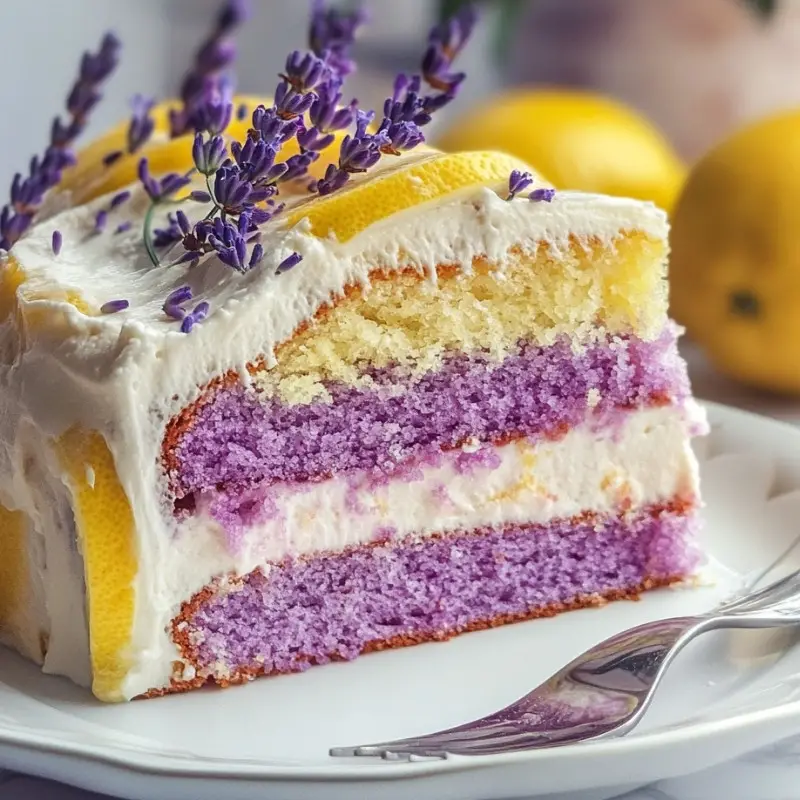
Introduction
Lemon Lavender Dream Cake is a delightful culinary creation that promises a refreshing and fragrant experience. This cake captures the vibrant essence of lemon and the subtle, aromatic notes of lavender, making it a perfect dessert for brunches, baby showers, or springtime celebrations. The harmonious blend of citrus and floral flavors creates an unforgettable taste sensation that will leave your guests enchanted.
Detailed Ingredients
To create this exquisite cake, you will need:
– 1 cup of unsalted butter, softened. This forms the creamy base for your cake batter.
– 2 cups of granulated sugar for a sweet, caramelized crust and sweetness throughout.
– 4 large eggs at room temperature, which act as a binding agent and provide structure.
– 2 ½ cups of all-purpose flour, serving as the structural foundation of the cake.
– 1 tablespoon of baking powder to help the cake rise and achieve a light texture.
– ½ teaspoon of salt to balance sweetness and enhance flavors.
– 1 cup of whole milk for moisture and richness.
– 2 tablespoons of fresh lemon zest, offering vibrant citrus aromas.
– ⅓ cup of freshly squeezed lemon juice for a tangy punch.
– 2 teaspoons of finely ground culinary lavender, lending subtle floral notes.
– 1 teaspoon of vanilla extract for a warm, smooth flavor undertone.
For the Lavender Lemon Buttercream:
– 1 ½ cups of unsalted butter, softened, for a creamy, rich frosting.
– 5 cups of powdered sugar to give sweetness and structure.
– ¼ cup of heavy cream for lush, whipped consistency.
– 2 teaspoons of lemon extract to infuse more citrus flavor.
– 1 teaspoon of vanilla extract to deepen the flavor profile.
– 1 teaspoon of finely ground culinary lavender, adding aromatic floral tones.
– Purple food coloring (optional), for an aesthetically pleasing lavender hue.
Prep Time, Cook Time, Total Time, Yield
This Lemon Lavender Dream Cake takes approximately 30 minutes to prepare. The baking process requires an additional 30 minutes, making the total time 1 hour. When baked and assembled, the cake yields approximately 12 generous servings, perfect for entertaining a small gathering.
Detailed Directions and Instructions
1. Begin by preheating your oven to 350°F (175°C). This ensures that the oven is at the correct temperature when it’s time to bake. Prepare three 8-inch round cake pans by greasing them and lightly dusting with flour to avoid sticking.
2. In a large mixing bowl, cream together the softened butter and granulated sugar until the mixture is light, fluffy, and pale in color. This incorporates air, which is crucial for leavening.
3. Incorporate the eggs one at a time, beating well after each addition. This ensures a smooth, stable batter that can trap air.
4. In a separate bowl, mix the flour, baking powder, and salt thoroughly. This evenly distributes the baking powder which is a leavening agent.
5. Prepare the wet mixture by combining milk, lemon zest, lemon juice, finely ground lavender, and vanilla extract in a small bowl. The acid in the lemon juice may cause slight curdling — this is normal and combines smoothly with other ingredients.
6. Gradually add the dry ingredients to the butter mixture, alternating with the milk mixture. Begin and end with the dry ingredients. Mix until just combined to avoid overworking the batter.
7. Divide the batter evenly among the prepared cake pans, smoothing the tops with a spatula for even baking.
8. Bake the cakes for 25-30 minutes, or until a toothpick inserted into the center comes out clean. This indicates the cake is done.
9. Allow the cakes to cool in their pans for about 10 minutes before turning them out onto a wire rack to cool completely. This avoids sogginess at the bottom.
10. Meanwhile, prepare the buttercream by beating the softened butter until creamy and light. Gradually add the powdered sugar, mixing well after each addition.
11. Slowly incorporate the heavy cream, lemon extract, vanilla extract, and ground lavender, beating until the mixture is light and fluffy. Add a few drops of purple food coloring, if desired, for a lavender hue that complements the flavor profile.
12. Once the cakes have completely cooled, stack them by spreading a layer of buttercream between each. Use the remaining buttercream to frost the top and sides of the cake smooth and evenly.
13. For an elegant finish, decorate with additional lemon zest or sprigs of lavender if desired.
Notes
– Using fresh, organic lemons will yield the best zest and juice for your cake.
– Fine grating of lavender ensures it distributes evenly without the risk of overpowering the cake with floral tones.
– If culinary lavender is unavailable, ensure your lavender is safe for consumption.
Cook Techniques-FAQ
To achieve a light, airy crumb in your cake, ensure all ingredients are at room temperature. This aids proper emulsification and incorporation. When incorporating flour, use a gentle folding technique rather than beating to preserve air bubbles.
FAQ:
Q: Is it possible to make this cake gluten-free?
A: Yes, substitute the all-purpose flour with a gluten-free flour blend designed for baking. Ensure that the blend contains a binding agent like xanthan gum.
Q: Can I use dried lavender flowers instead of ground lavender?
A: Yes, but they should be finely ground in a spice grinder to release the oils and ensure even mixing in the batter.
Conclusion
Lemon Lavender Dream Cake is the perfect culinary confluence of citrus zest and floral aroma. Its light, fluffy texture and the luxurious frosting make it a show-stopper dessert that is as delightful to the eye as it is to the palate. Tailor its decoration to suit the season or occasion, knowing it will captivate taste buds and hearts alike.
More Recipes Suggestions and Combination
Once you’ve mastered the Lemon Lavender Dream Cake, consider exploring similarly aromatic combinations. Try an orange blossom and pistachio cake or perhaps a rosewater and cardamom dessert. For a savory twist, experiment with lavender-infused scones or lemon-thyme bread. The possibilities for floral and citrus pairings in both sweet and savory dishes are as abundant as they are tantalizing.

Lemon Lavender Dream Cake
Ingredients
Method
- Preheat your oven to 350°F (175°C) and prepare three 8-inch round cake pans by greasing and dusting with flour.
- In a large bowl, cream together softened butter and granulated sugar until light and fluffy.
- Incorporate the eggs one at a time, beating well after each addition.
- In a separate bowl, mix the flour, baking powder, and salt.
- Combine milk, lemon zest, lemon juice, ground lavender, and vanilla extract in a small bowl.
- Gradually add the dry ingredients to the butter mixture, alternating with the milk mixture.
- Mix until just combined to avoid overworking the batter.
- Divide the batter evenly among the prepared pans and smooth the tops.
- Bake for 25-30 minutes or until a toothpick comes out clean.
- Allow cakes to cool for about 10 minutes before transferring to a wire rack.
- Beat the softened butter until creamy, gradually adding powdered sugar.
- Incorporate heavy cream, lemon extract, vanilla extract, and ground lavender, beating until fluffy.
- Add food coloring if desired.
- Once cakes are cooled, stack with buttercream between each layer.
- Frost the top and sides of the cake with remaining buttercream.
- Decorate with additional lemon zest or lavender sprigs if desired.




